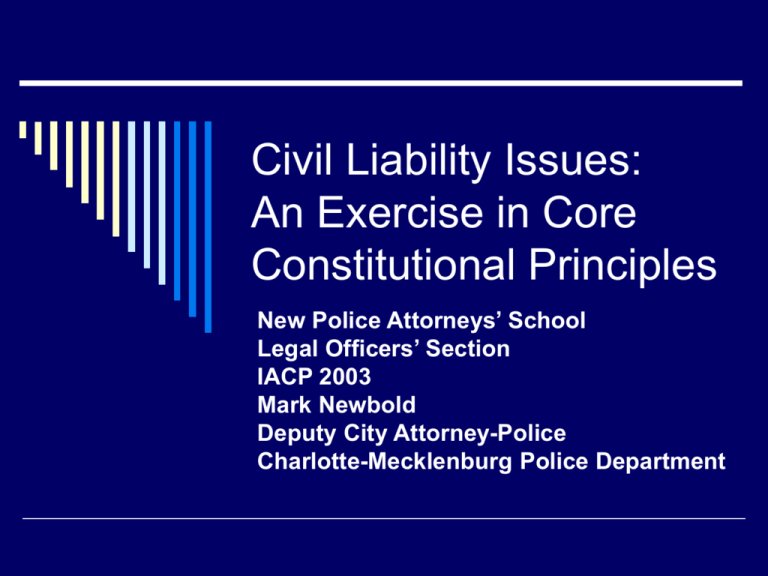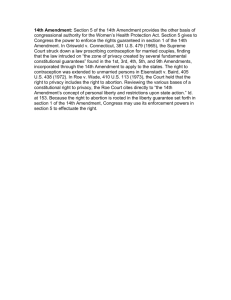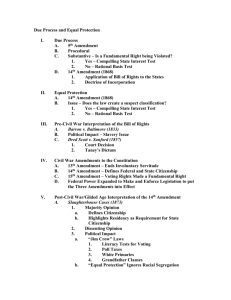Civil Liability Issues
advertisement

Civil Liability Issues: An Exercise in Core Constitutional Principles New Police Attorneys’ School Legal Officers’ Section IACP 2003 Mark Newbold Deputy City Attorney-Police Charlotte-Mecklenburg Police Department “Passive Protest” - Video “Passive Protest” Plaintiff’s Group Identify potential plaintiffs Identify potential federal cause(s) of action Identify defendant(s) Defendant’s Group What steps would you take to prepare for potential litigation? Identify Core Constitutional Issues. 1st Amendment “Congress shall make no law . . . Abridging the freedom of speech; or the right of people peaceably to assemble, and to petition the government for a redress of grievances.” 4th Amendment “The right of the people to be secure in their persons, houses, papers and effects, against unreasonable searches and seizures, shall not be violated, / and no warrants shall issue, but upon probable cause, supported by oath and affirmation, and particularly describing the place to be searched, and the person or things to be seized.” 14th Amendment Due Process . . . “nor shall any state deprive any person of life, liberty, or property . . .” Procedural Due Process Substantive Due Process Core Constitutional Principles Freedom of Expression “Free trade of ideas” 1st 14th Freedom From Arbitrary Governmental Action 4th Security in persons, houses papers and effects Legitimate Governmental Interests 1st Reasonable Time Place and Manner 4th Reasonable Search and Seizure 14th Due Process Essential Balancing Individual Constitutional Protections Legitimate Government Interests Fourth Amendment Analysis Is there a Seizure ? [B]y means of physical force or show of authority . . . in some way restrained the liberty of a citizen.” Terry v. Ohio, 392 U.S. 1, 19 n.16(1968) Officer terminates freedom of movement through means intentionally applied. Brower v. Inyo, 109 S.Ct. 1378 (1989); or Person submits to a show of authority. Fourth Amendment Analysis If seized, then may force be used? “The right to make an arrest or investigatory stop necessarily carries with it the right to use some degree of physical coercion or threat thereof to effect it.” Terry v. Ohio, 88 S.Ct. 1868, (1968). Fourth Amendment Analysis What is the degree (level or amount) of force that may be used? Force must be objectively reasonable. Its use is not capable of precise definition or mechanical application. What is the severity of the crime? Does the suspect pose an immediate threat to the safety of the officers or others? the suspect actively resisting arrest or attempting to evade arrest by flight? Is Use of Force/Analysis/4th “Reasonableness of a particular use of force must be judged from the perspective of a reasonable officer on the scene rather than with the 20-20 vision of hindsight.” “The calculus of reasonableness must embody allowance for the fact that police officers are often forced to make splitsecond judgments - in circumstances that are tense, uncertain, and rapidly evolving about the amount of force that is necessary in a particular situation.” Federal Case Law - 4TH Amendment Tennessee v. Garner, 105 S. Ct. 1694 (1985) Fleeing felon/deadly force rule “Thus, if the suspect threatens the officer with a weapon or there is probable cause to believe that he has committed a crime involving the infliction or threatened infliction of serious physical harm, deadly force may be used if necessary to prevent escape, and if, where feasible, some warning has been given.” 14th Amendment-Due Process . “nor shall any state deprive any person of life, liberty, or property . . .” without due process of law. Use of Force 14th Amendment Due Process Clause Prohibits arbitrary governmental deprivations of life liberty and property without due process. Prevents governmental officials from abusing their power, or employing it as an instrument of oppression. 14th Amendment Use of Force When does it attach? Search and Seizure 14th Amendment Non-Seizure Disperse Attempt to seize Pursuit 4th No cruel and unusual punishment 14th Amendment Post-Seizure Special Relationship In Custody Created Danger 8th Use of Force 14th Amendment Shocks the Conscience Special relationship established by State Danger Created by State Substantive Due Process “Shocks the Conscience” “Thus in a due process challenge to executive action, the threshold question is whether the behavior of the governmental officer is so egregious, so outrageous, that it may be so fairly said to shock the contemporary conscience” Lewis at 1716 at n.8 14th Amendment Special Restraint on person’s liberty Assuming control over the person A State's failure to protect an individual against private violence simply does not constitute a violation of the Due Process Clause. DeShaney v. Winnebago,109 S.Ct. 998(1989). Danger Relationship. Creation. State creates the danger that harmed the individual. 14th Amendment – Danger Creation State created the danger Plaintiff was a member of a limited group States conduct put Plaintiff at a substantial risk of serious, immediate and proximate harm State acted recklessly in conscious disregard of that risk State’s conduct when viewed in total was conscience shocking 1st Amendment Threat level Is the Speech protected? Not all expressive symbolic speech is protected True Threat (Virginia v. Black) Intimidation True Threat Political Speech Plus a little spice Bradenburg Political Speech 1st Amendment Analysis True threat (Order to Disperse) Those forms of intimidation designed to inspire fear of bodily harm. Thus just as a State may regulate only that obscenity which is the most obscene due to its prurient content, so too may a State choose to prohibit only those forms of intimidation that are most likely to inspire fear of bodily harm.” Virginia at 123 S.Ct. 1536 (2003) First Amendment - Analysis Analysis Does the person have a right to be at that location Public forum? Public property which has by law or tradition been given the status of a public forum. A place where people have traditionally be allowed to associate and speak for or against certain subjects. First Amendment - Analysis If public forum, then is the restriction content based? (Is the restriction triggered by the Speaker’s message or has a crime occurred?) If the restriction is content based, then the restriction is subject to the highest degree of constitutional scrutiny. (strict scrutiny request) Restriction will withstand constitutional review only if it was necessary and narrowly tailored to achieve a compelling public interest. First Amendment - Analysis Analysis Is restriction content neutral a content neutral restriction is one that regulates time, place or manner. The restriction will withstand constitutional review if the implicated measure was narrowly fashioned to further a significant governmental interest, and it leaves open ample alternate channels of communication. (intermediate scrutiny test) First Amendment - Analysis Rationally related test If action does not invade any fundamental right, then governmental restriction survives so long as it is rationally related to the advancement of a legitimate state interest.. Defendants What steps would you take to prepare for potential litigation Identify Core Constitutional Issues Less Lethal/Relationship to Core Constitutional Principles Use of “less lethal” to Reasonable Seizure Physical force Chemical agents to seize Taser to seize Horses to contain Use of less lethal to Disperse Use of Less Lethal / Due Process/First Amendment Verbal Commands Physical Coercion to disperse Chemical Agents to disperse Taser to disperse Physical force to disperse Conclusion Core Principles 1st Promotes free trade of ideas Level of protection depends on the content and location 4th Protects security interest in person homes places and effects 14th Due Process Clause Prohibits arbitrary governmental action






